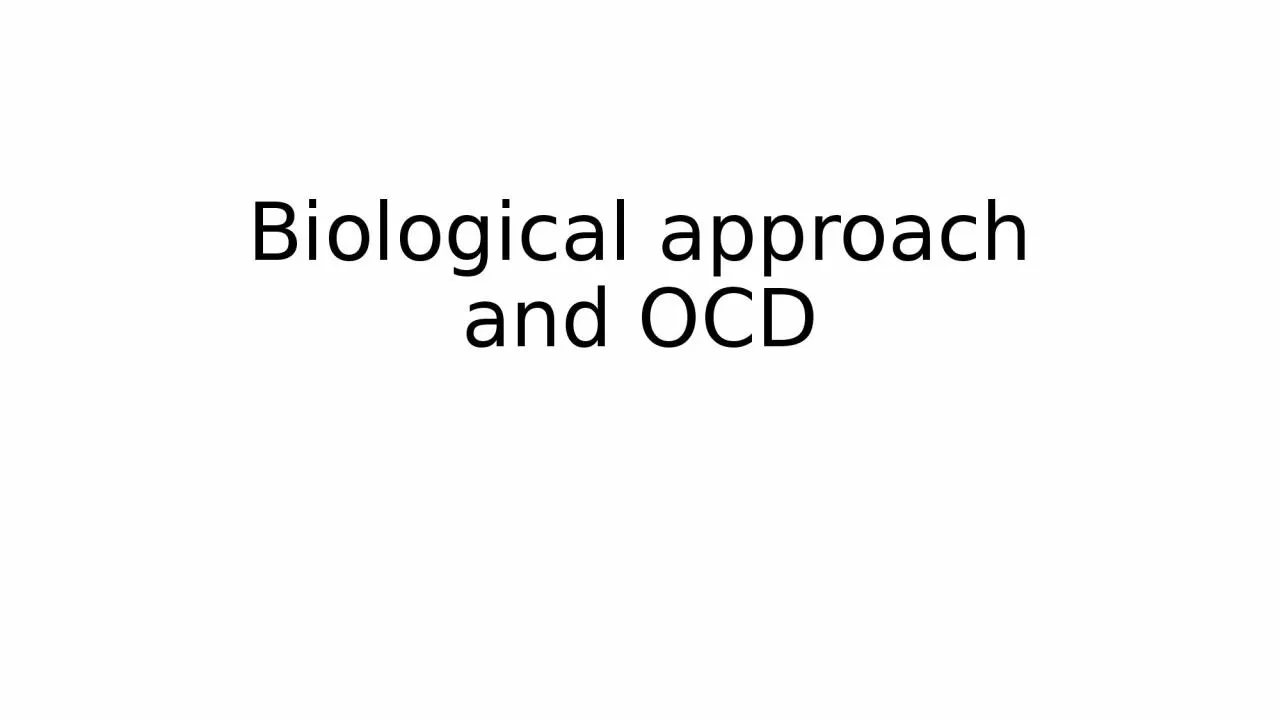

I nstructions Read the following info slide on genetics and behaviour Complete task 1gt twin study worksheet Use the internet to find out what a family study is and how they are conducted Read over page 31 in psychopathology pack and make notes on any new terms eg polygenic ID: 1018716
Download Presentation The PPT/PDF document "Biological approach and OCD" is the property of its rightful owner. Permission is granted to download and print the materials on this web site for personal, non-commercial use only, and to display it on your personal computer provided you do not modify the materials and that you retain all copyright notices contained in the materials. By downloading content from our website, you accept the terms of this agreement.
1. Biological approach and OCD
2. InstructionsRead the following info slide on genetics and behaviourComplete task 1-> twin study worksheetUse the internet to find out what a family study is and how they are conducted?Read over page 31 in psychopathology pack and make notes on any new terms e.g. polygenicComplete Task 2-> True or false questions (on this powerpoint)Find out what a neurotransmitter is and where you find them?Find out what a PET scan isLook at the 3D brain app online (or download) to find out where the orbitofrontal cortex and the caudate nucleus are in the brain. Complete Task 3-> What role do neurotransmitters and brain areas play in OCD? (use page 33 to help) Extension-> Watch the Jim Twin video and answer the questions (last slide)
3. Same person tested twice87%Identical twins reared together86%Identical twins reared apart72%Non-identical twins reared together60%Biological siblings reared together47%Parents and children living together42%Cousins15%Unrelated people living apart0%Genetics and BehaviourHeredity is the passing of characteristics from one generation to the next through genes. Genes carry the instructions for a particular characteristic (such as temperament or intelligence), but how this characteristic develop partly depends on the interaction of the gene with other genes and how they interact with the environment (nature vs nurture debate). Genotype and PhenotypeThe Genotype of a person refers to their genetic make-up inherited from parents. For instance, a person may have genes that code for being tall. The Phenotype of that person is the physical appearance and observable characteristics and behaviour that depend on genes and environment. For example, height may be reduced by a child’s diet or by illness.The Genotype can only be known from studying a person’s genetic code since anything we observe is a Phenotype. The Genetic basis of behaviourStudies have often used twin and family studies to investigate heritability; how likely it is that a characteristic can be explained genetically. The logical assumption is that individuals who are more closely related genetically are likely to share the same or similar characteristics. The most genetically similar people are identical (monozygotic – meaning one egg) twins, assumed to be 100% alike. Dizygotic (two eggs) twins, siblings and parent-child share 50% of their genes. Therefore it would be expected that something like intelligence, if genetic, would lead to a perfect (+1) correlation between identical twins and a strong positive (+0.5) correlation for those sharing 50% of genes. A meta-analysis of studies found the following concordance rates. A perfect concordance would be 100%.The findings suggest there is a genetic component to intelligence but the fact that identical twins and one person tested twice do not yield 100% concordance rates shows that genes are not the only influence on measured intelligence.
4. Complete twin study worksheet
5. True or false questionsThe genetic explanation to OCD is part of the cognitive approach. The genetic explanation looks at if individuals inherit a genetic disposition to developing OCD. An example of your first degree relatives would be your grandad or uncle.A family study by Nestadt found concordance rates of 11.7% for first degree relatives compared to 2.7% in the control group. A concordance rate is the probability that a pair of individuals will both have for e.g. OCD, given that one of the pair already has OCD. The concordance rate found by Carey (1981) for MZ twins suffering obsessive symptoms was 100% compared to 0% for DZ. Two candidate genes that are seen to be involved in OCD are COMP and SERPFalse – COMT and SERTHowever, OCD seems to be polygenic and it is thought that there may be up to 230 genes involved in its cause.
6. Watch the videohttps://www.youtube.com/watch?v=qw3S35wGgT8Now on MWBs What is a DZ twin?What is an MZ twinWhat type of twins were the JIMS?What is a concordance rate?Research in your flip showed that there was a concordance rate of 86% for MZ twins and 60 % for DZ intelligence How does this support the role of Genes in Behaviour?What would the concordance rate need to be to conclude something is totally genetic?Why is it difficult to study twins and confirm a genetic basis of behaviour?Why is the case of the Jim Twins therefore so useful to Psychologists aiming to explain the genetic basis of behaviour? Application of the FlipThe Jim Twins